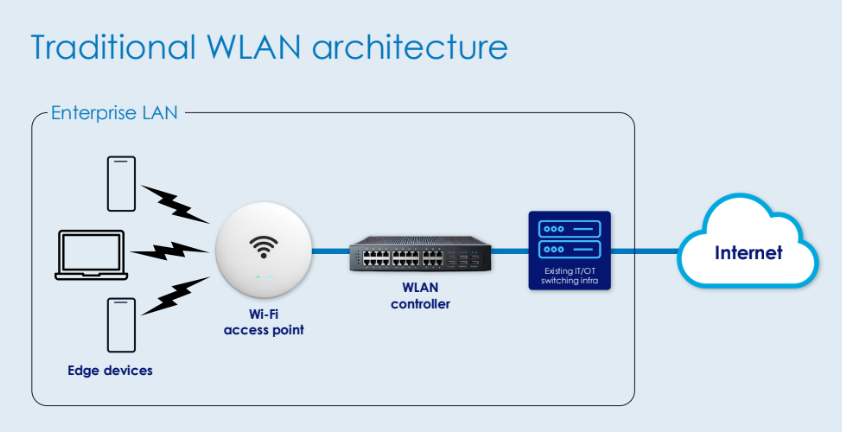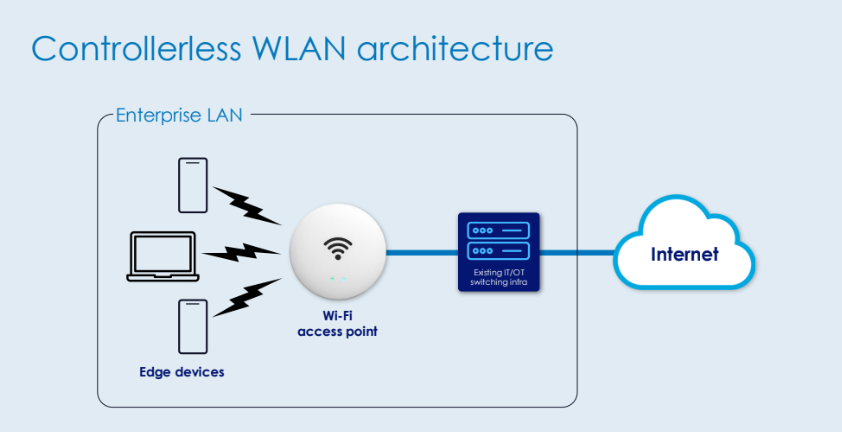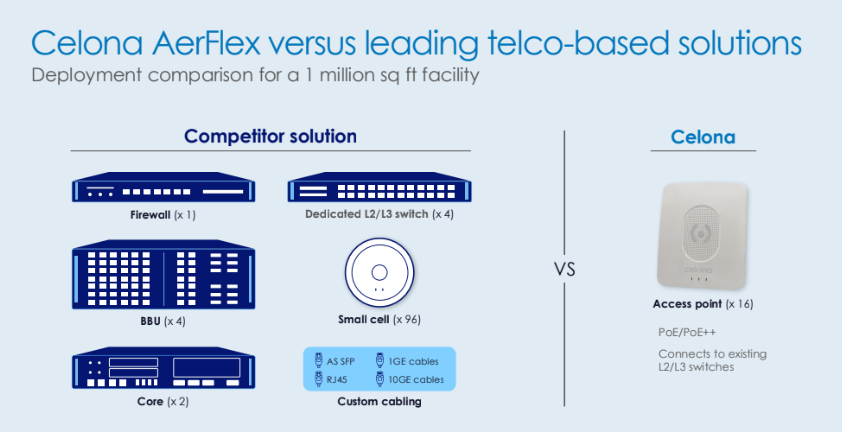Celona’s new AerFlex system does away with expensive edge hardware and complex RF management to offer easy cloud orchestration and compliant local breakout – to open private 5G to new segments; US manufacturer Cargill is testing the product at 20 sites.
In sum – what to know:
Clever system – new hybrid-style private 5G solution splits core functions between on-site RAN access points (APs) and cloud management system.
Simple setup – purpose is to simplify setup and management, versus rival systems, and make private 5G feasible for a wider enterprise market.
Mass market – pitched to SMEs and big firms’ satellite offices; US manufacturer Cargill is testing at 20 sites; promises scalable foundation for AI.
Silicon Valley specialist Celona has launched a clever new hybrid-style private 5G proposition, called AerFlex, which splits network functions between on-site RAN access points (APs) and a cloud-based network operating system in order to simplify the setup and management, and make private 5G feasible for a much wider enterprise market. It appears like a private 5G-lite solution – more capable than Wi-Fi, more approachable than private 5G – which moves certain core network functions from traditional edge-based server hardware into AP radio units, and provides remote cloud control so on-site enterprise IT/OT staff are not required to manage new RF systems.
But it also claims critical-level security by leveraging (standard 3GPP-based) SIM-based identity and access control, end-to-end encryption, and (increasingly-standard) zero-trust segmentation. As well, it offers local data breakout to ensure sensitive traffic remains on-site – and does not traverse the public cloud. (Although the control plane resides in the cloud, user traffic can be fully isolated and processed locally, addressing concerns around data sovereignty, compliance, and operational risk.) It brings consistency, too, for distributed enterprise setups, where security policies can be enforced in the centralised cloud control plane.


It is pitched for the giant engine room of the global economy, mostly comprising small and mid-sized firms (SMEs), and also the smaller satellite operations of mega-sized multinationals. A press note about the product included a public reference to its first (beta) customer: US process manufacturing giant Cargill, a $165 billion business with operations in 70 countries. Cargill is testing AerFlex to connect warehousing in 20 satellite offices – to “streamline manufacturing processes, improve supply chain efficiency, and automate forklifts”. Cargill has spoken at length in these pages before to present a counter-narrative to well-circulated Wi-Fi swap-out stories from the likes of Airbus and John Deere.
Cargill is not “ripping all that out”, it said, just to replace paid-for networks with expensive new private 5G systems. Robert Greiner, director of platform engineering for digital technology at Cargill, said of the AerFlex trial: “Cargill operates over a thousand locations worldwide, many in remote or space-constrained environments where traditional infrastructure just doesn’t work. [This] gives us a secure, scalable private 5G solution that supports the growing role of AI and automation across our operations. Its innovative design and cloud-based management simplify deployment by eliminating the need for dedicated IT personnel at each location.”
But the SME market, in particular, is the gateway for proper scale in the private 5G industry. As an aside, a recent forecast from Kaleido Intelligence said the private 5G market will grow at a remarkable rate (500 percent) in terms of network deployments over the next five years, but that the average revenue per network (ARPN, anyone?) will tumble at the same time – as the market goes beyond deep-pocketed early adopters and smaller enterprises take smaller installations. Nokia, in particular, has been chasing this long tail for some years by shrinking its edge-core solution by degrees; it now offers ‘compact’ and even ‘ultra-compact’ solutions for small campuses and SMEs.
But Celona’s move to split the control plane and user plane into the edge and cloud appears novel. And the California firm, as it does, compared AerFlex quite readily to legacy-vendor solutions in the space; without saying it, the firm has Nokia (and Ericsson) in its sights, presenting itself as the IT-friendly antidote to their telco bloat. AerFlex “eliminates the complexity of traditional deployments”, it stated. “Unlike legacy telco solutions that retrofit complex infrastructure for enterprise use – or fragmented small cell systems that require multi-vendor integration – Celona AerFlex introduces a fundamentally different approach.” For a press release, it sounds like fighting talk; an image in a briefing deck (see below) showed it side-by-side with standard fare.

Celona went on: “With an AP-only architecture, secure local data breakout, and cloud-based orchestration, [it] enables rapid rollouts – often in hours, not weeks. With its cloud-based control, AerFlex delivers centralized orchestration, built-in resiliency, and scalability. By intelligently splitting network functions between Celona access points and the cloud and leveraging CelonaOS – the industry’s only unified private 5G operating system – AerFlex delivers seamless integration across radio, core and AI-powered management.This innovative architecture sets a new standard for simplicity, scalability and performance in enterprise connectivity.”
Rajeev Shah, co-founder and chief executive at Celona, commented: “Celona AerFlex marks a major leap forward in making private 5G truly accessible and operationally efficient for enterprises of all sizes. By combining innovation with radical simplicity, we’re removing the traditional barriers to private 5G adoption – enabling more organizations to harness its performance, reliability, and security at a time when AI is transforming every industry.”
The AI angle is rather under-played in the press notice – or over-played and under-explained. But it is interesting, as well – and RCR Wireless is putting together a report on this combination of 5G and AI in Industry 4.0, and hopefully Celona will say more. It stated: “As AI-driven operations gain momentum across industrial sectors, the demand for reliable, high-performance wireless connectivity is accelerating. Private 5G is rapidly emerging as the preferred solution in environments such as refineries, manufacturing plants, warehouses, and mining operations – where traditional Wi-Fi often falls short. With its game-changing architecture and cloud-native design, Celona AerFlex is the ideal foundation for industrial AI.”
A supplied quote from Pablo Tomasi, analyst at Omdia, said: “As enterprises accelerate industrial AI at the edge, they need private 5G solutions that combine simplicity, agility and control. Celona AerFlex stands out with its AP-only model and cloud-native architecture – eliminating traditional deployment complexity while delivering secure, low-latency performance. Its integrated design uniquely positions it to meet the strategic demands of modern enterprise networks.”

